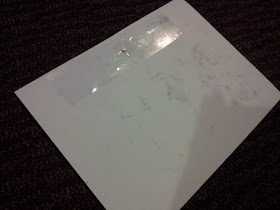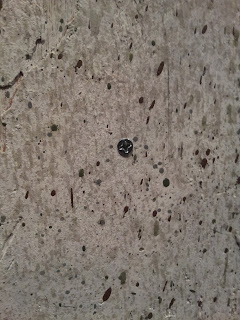She also asked me a very interesting question- What makes me want to work with a company that can't pay me what I'm worth? What can a small company offer to me as an artist, besides money, to make me want to work with them.
I gave her a long list, and I figured, why not share it with anyone else who could use it.
In no particular order:
- Be up front with me from the first email. "We don't have a lot of money" is what I usually hear, which is honest, but if I don't know exact dollar amounts, it is impossible to have a productive conversation. This is partially because I need to look at my personal budget and see if I can afford to do this show, but more because I need to know if it is possible to do the show, at the level of quality I hold myself to, for the amount in the budget.
- On a similar point, it is really helpful to have a conversation with the director about what is possible and what is not possible for me to do on this show with this budget. If the director and I start out on the same page, the budget can be any size, but if the director has aspirations bigger than her budget, it doesn't matter what size the budget is, we will both end up unhappy with the end product.
- Treat the things I provide you with respect. I will not get frustrated if something breaks, especially in rehearsal when you are trying new ideas, that is part of the process. I will get frustrated if pieces are lost, or not stored safely, or if I give you specific instructions for the use or care of something and those instructions are ignored.
- Get me involved in the production process as soon as possible. I love working on shows where production meetings start months before the first rehearsal, even if we only have one or two. I love to be in a room full of artists talking about the meaning of the play, what we would like to communicate to the audience, what sort of language we all want to work with in terms of color, and shape and texture that could apply to all design elements? I love conversations about why we are doing this show in this time and this place, who our audience is, how we want them to interact with the characters etc. Productions that start this way always seem to lead to more collaborative production teams, which helps produce work that we can all take pride in.
- Continue that type of artistic collaboration throughout. I distinctly remember sitting in a production meeting after a first preview; the lighting designer mentioned that he had been distracted during the performance by the squeaking stool in the stage manager's booth behind him, he figured that she may not have been aware that the sound was carrying. The ASM indignantly turned to the room and asked "Did the lighting designer just give stage management a note?" The room went silent, and after that no designer felt very comfortable giving a suggestion or even asking a question to another department, and an atmosphere like that can only hurt a show. An open conversation between all departments about what is working and what isn't from sound cues to script choices allows everyone in the room to take advantage of the collective knowledge of so many theatre practitioners Collaborative environments with open conversations make me feel like I am growing as an artist, and that makes me want to come back to work with you.
- Feed me. I know it's little and I know it's silly, but something to eat that I don't have to think about goes a long way to making tech more pleasant and making me feel appreciated. Also if I am running around like that, I often forget to eat, and I get pretty cranky before I realize I'm probably just hungry, this is not a time when I am doing my best work.
- Do something about parking if possible. If you can make an arrangement with a local lot, or reimburse me for some of my meter receipts, or even have an ASM ready to run out and grab something from me when I pull up so that I don't have to circle for an hour to find a space close enough that I can carry all the everything from my car, that would be awesome. While many theatres in town are easily accessible by public transportation, that doesn't help me when I have a car full of props (costume designers have this issue too, help them out if you can).
- I worked with a theatre that did a talkback with each person involved after each show. I met two company members (who had not been directly involved in this production) for coffee and talked for an hour about what went well, what didn't, what I would do differently if I could do it again, and then about what my career goals and aspirations were in general. It was awesome. It made me feel appreciated, respected, and I got some great feedback and career advice.
- Get me keys to the space, if you can (if you are renting I know this is much less doable). If I can drop off big pieces at any time of day regardless of who else is around and available it makes my job so much easier. It is hard to keep shopping for furniture if there is a dining table taking up the entire bed of my pickup truck.
- Pay attention from the beginning to where the trouble spots are going to be. One of my favorite theatre companies does this particularly well. Time, labor, and budget resources are directed to the department who will need them most. I know if I am doing a big props show with them I will have a bigger budget, a bigger fee, a few more one-on-one meetings with the director and/or the set designer and I'll have the production manager offering to help me track down big pieces. I see the same support being thrown behind other designers when it is a heavy costume or lights show. If I know I will be taken care of when I need help, I will keep coming back regardless of whether the support was directed to my department this time.
- Do interesting shows with a clear mission. The more targeted you are about what you do and what makes you different from everyone else, the more intriguing you are. The more passionate you are about WHY you choose to do what you do, the more likely I will becoming interested and involved in your mission and invested in your success. The rule of thumb I tell people is, that I should be able to give you ten amazing plays that you would love to see, and you should be able to eliminate seven of them immediately because they aren't a good fit for your company. If you can't do that, you need a more focused vision.
- Prop Freeze! This is my favorite new thing. The idea is that we set a date during the rehearsal process when the director is supposed to stop adding new props (with a couple of companies this has been first tech). After the freeze date the director can still ask for new things and for changes, and I will do them to the best of my ability, but I also have the ability to tell them without any guilt that there is no longer enough time or money to make that change. With some directors, this would hardly ever come up, but with others, it's really good to know I have a safety net in case they make a last minute outlandish request.
- Get me help. I have lots of ways I can use untrained labor. There is always a repetitive project that could use another set of hands, and I love to teach. Even one or two hours on one day can be awesome and make me feel supported.
- Understand that I will likely leave when I'm done. Especially on smaller shows, if I have completed all of my notes and haven't been getting notes from other people, I'm probably going to stop coming to previews and I may not make it to opening. This is not because I don't like the show or hanging out with you, this is probably because I need to start working on my next show. If you are understanding and respectful of this, I am much more likely to want to work with you again.
- Remember, I need to keep working with these vendors. A few years ago, I performed a props miracle and was able to get a high-end furniture store to loan me several expensive modern furniture pieces for a production. At the time I was driving a small car, but the company manager assured me that they had someone with a pickup who would help to return the pieces to the store after strike. I learned about a year later that they never returned the pieces. I could never bring myself to show my face in that store again (it recently closed).
- Hire cool people. A lot of this will be contingent on doing some of these other things so that the cool people want to keep coming back. Nothing will make me sign on for a low paying show quicker than a list of people involved that I like working with.




























